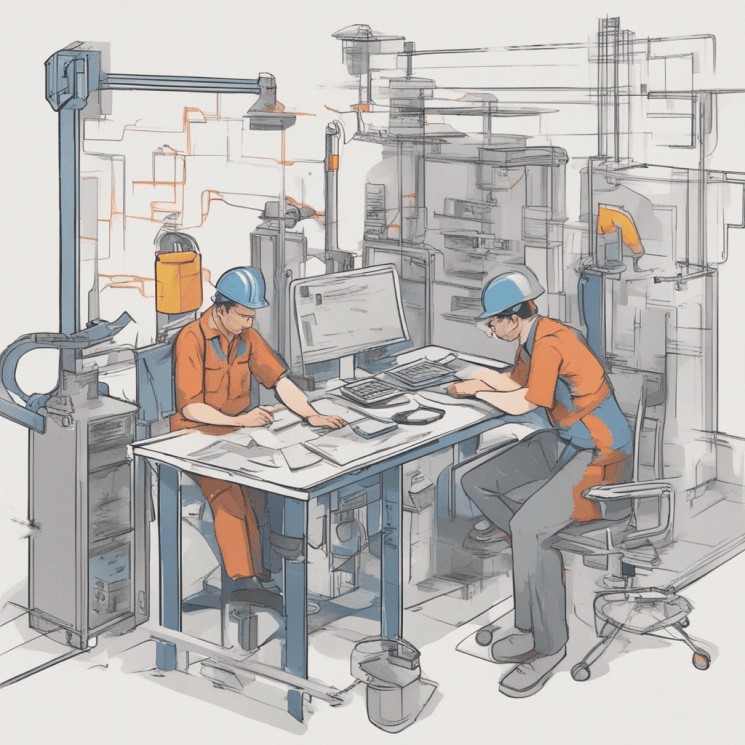Picture this: You’re the owner of a rapidly growing, successful e-commerce platform. One day, your website crashes. Customers can’t make purchases, engineers struggle to identify the issue, and revenue starts to drop. This is where SRE comes into play: ensuring your website is consistently operational—a crucial factor for any online business.
Site Reliability Engineering (SRE) has emerged as a buzzword in the tech industry in recent years. While giants like Google, Amazon, and Netflix have employed SRE practices for years, only now are more companies beginning to adopt this approach. Still, many need clarity on this concept and how it integrates into their existing software development lifecycle.
So, what exactly is SRE? Why is it crucial? And how does it differ from DevOps?
What is SRE?

At its heart, SRE constitutes practices aiming to enhance the reliability and availability of software systems. Merging software engineering, systems engineering, and operations, SRE focuses on designing, building, and maintaining large-scale, fault-tolerant systems with high reliability. Imagine Iron Man refining his suit to withstand the mightiest adversaries. That’s the SREs’ mission with their systems: making them resilient, reliable, and battle-ready.
SRE’s essence lies in developing and preserving highly reliable, scalable systems. These teams strive to maintain consistent service availability and optimal performance—even amid unforeseen events like traffic surges or hardware failures. They prioritize automating recurring tasks to minimize human error, covering areas like deployment, monitoring, and incident response. This is achieved using scripting and automation, streamlining IT operations such as maintenance, support, and other routine tasks.
SRE operates on the belief that software systems are products—with reliability as a chief characteristic. SRE teams collaborate with developers to ensure newly introduced features prioritize reliability. They also liaise with operations to guarantee systems’ high availability and scalability. A fundamental SRE principle is maximizing automation in tasks like infrastructure management, code deployment, and system monitoring. Such automation enables SRE teams to enact changes swiftly, minimizing new error introductions.
Why Is SRE Important?
- Improved Reliability: SRE methodologies significantly elevate software system reliability. By viewing reliability as a product trait, SRE teams ensure systems remain accessible, even during unforeseen outages. Moreover, they counteract performance drops that could deter customers and cut revenue.
- Reduced Downtime: E-businesses heavily depend on their sites for revenue. Any operational halt can tarnish a brand’s image and risk sales. SRE reduces such risks, ensuring uninterrupted system operations. Proactive monitoring and alerts help SRE teams detect and rectify issues early, precluding major setbacks.
- Increased Scalability: SRE can bolster system scalability. Automated infrastructure handling and deployment let SRE teams swiftly allocate new resources as demand grows.
- Quick Recovery: SRE also diminishes the mean time to recovery (MTTR) post incidents, ensuring rapid problem resolution, thus minimizing business impact.
SRE vs. DevOps

While SRE and DevOps terms often intertwine, they aren’t identical. DevOps represents a cultural and organizational model stressing synergy between development and operations units, aiming to boost software delivery speed and quality.
Conversely, SRE is a specialized DevOps offshoot centering on reliability. Even though SRE teams liaise with both development and operations, their chief objective remains system reliability, continuous uptime, and scalability.
Having distinguished between SRE and DevOps, let’s explore SRE Incident Management.
SRE Incident Management
Incidents are inevitable in any system. Among the primary roles of an SRE team is incident management. When such events arise, the SRE team quickly identifies the problem, ascertains its origin, and executes solutions.
SRE teams employ a range of tools and methodologies to handle incidents. Early detection is facilitated by monitoring and alerting systems, enabling prompt responses. Moreover, post-mortem analyses are conducted to pinpoint incident root causes and introduce measures preventing future recurrence.
Incident management often involves:
- Detection: Utilizing monitoring tools for prompt incident identification.
- Escalation: Should the initial team fail to resolve an issue, escalation to a senior member occurs.
- Diagnosis: Root cause determination of the incident.
- Mitigation: Steps are taken to lessen the incident’s impact.
- Resolution: Final resolution and measures to avert future recurrences.
What is an SRE Framework?

An SRE Framework is a set of practices and processes that SRE teams follow to ensure that systems are reliable and scalable. An SRE Framework typically includes the following components:
Service Level Objectives (SLOs): SLOs define the desired goals or level of reliability and performance that a system should achieve. These objectives are typically measured through metrics such as uptime, response time, and error rates. SRE teams set specific targets for these metrics based on the system’s requirements and user expectations.
Error Budgets: Error Budgets provide a mechanism for balancing system stability and innovation. It represents the acceptable amount of downtime or errors that can occur within a given timeframe without violating the SLOs. SRE teams use error budgets to make informed decisions about when to prioritize stability and when to invest in new features or optimizations. Error budgets are basically the amount of time that a system can be down before it violates its SLOs.
Monitoring: Monitoring plays a crucial role in the early detection of issues and anomalies within a system. SRE teams employ monitoring tools and techniques to collect and analyze various metrics, logs, and traces. By closely monitoring system health, performance, and user experience, SRE teams can proactively identify potential problems and take corrective actions before they impact users.
Deployment: SRE teams leverage automation to streamline the deployment process and ensure its reliability. Automated deployment pipelines enable the safe and efficient rollout of code changes, reducing the risk of errors and minimizing downtime. Through practices like continuous integration and continuous deployment (CI/CD), SRE teams can achieve faster and more frequent deployments while maintaining the system’s stability.
Incident Management: Incident management processes are crucial for effectively handling and resolving incidents that occur within a system. SRE teams establish incident response procedures, including incident detection, escalation, communication, and resolution. They focus on minimizing the impact of incidents on users and strive to restore normal system operations as quickly as possible. Post-incident analysis is also conducted to learn from the incident and implement preventive measures.
Some common SRE frameworks include Google’s SRE framework and the SRE framework developed by the Site Reliability Engineering Foundation (SREF).
SRE Roles & Responsibilities
SRE teams are typically responsible for ensuring that systems are always up and running. This includes:
- Monitoring: SRE teams use monitoring tools to detect issues as soon as possible.
- Incident Response: SRE teams respond to incidents and work to resolve them quickly and effectively.
- Automation: SRE teams automate repetitive tasks to reduce the likelihood of human error.
- Performance Engineering: SRE teams work to ensure that systems are performing well, even in the face of high traffic volumes.
- Capacity Planning: SRE teams plan for future growth and ensure that systems can handle increased traffic volumes.
Interview with Ahmad, a Site Reliability Engineer at a Fintech Company
“My role as an SRE involves providing value to my company, which might mean different things depending on the company’s priorities. I get to apply my experience to address challenges in areas like platform engineering, distributed systems consultancy, or even rebranded ops groups. This often involves a complex mix of technical skills, adaptability, and cultural understanding.”
“You’ll come to encounter a diverse set of tools and approaches, so be prepared to learn quickly and demonstrate value by solving problems effectively. Expect to do a lot of learning; working with new tools like Kubernetes, Auth0, GitHub, and Prometheus. Plus, essentially, you’d be working with chaos engineering platforms, monitoring and observability systems, to name a few.”
“As such, you’d have to be okay with embracing change, adapting your skills, and collaborating with diverse teams. For example, in my first few weeks at my current place of work, I noticed that the company’s incident response process was not as structured as my previous place of work. They often had some incidents dragging on due to communication gaps.”
“Drawing from my previous experience, I suggested implementing a post-incident review framework inspired by Google’s practices because they’ve perfected their SRE culture, some of which are sort of like the de facto standard. I collaborated with my colleagues to create a document that detailed our incident timelines, root causes, and action items. Over time, this framework has led to more effective incident response and improved team collaboration, making our platform more responsive to incidents.”
“Overall, it’s a challenging, yet rewarding role”.
Conclusion
In conclusion, Site Reliability Engineering (SRE) has emerged as a crucial discipline for ensuring the reliability and availability of software systems, particularly in the context of online businesses. By combining software engineering, systems engineering, and operations, SRE teams focus on designing, building, and running large-scale, fault-tolerant systems that are highly reliable. Through automation, SRE teams streamline various IT operations responsibilities, reducing human error and enabling quick and efficient deployment, monitoring, and incident response. The importance of SRE lies in its ability to improve reliability, reduce downtime, increase scalability, and facilitate quick recovery in the face of incidents.
While often confused with DevOps, SRE is a specific implementation within the broader DevOps framework that prioritizes system reliability. SRE teams can effectively ensure system reliability and scalability by following an SRE framework that includes Service Level Objectives (SLOs), Error Budgets, monitoring, deployment automation, and incident management. Their responsibilities encompass monitoring, incident response, automation, performance engineering, and capacity planning, all geared toward maintaining highly available and performant systems. Ultimately, embracing SRE practices can be a game-changer for businesses striving to provide customers with a seamless and reliable online experience.
